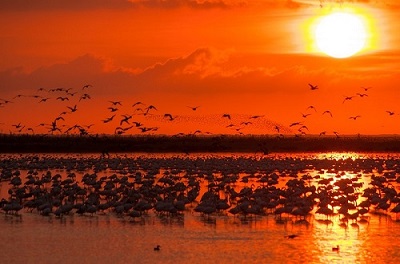Last January, the Natural Processes Monitoring Team (ICTS-RBD) of the Doñana Biological Station carried out the International Waterbird Census during winter in the Guadalquivir Marshes (Doñana Natural Space, adjacent unprotected areas and Brazo del Este Natural Site), coordinated by Wetlands International. The total estimated number of birds registered was around 532 thousand, belonging to 91 different species.
This winter, flood conditions of the natural marshes of Doñana were lower than average, because of poor rainfall after summer. Therefore, the flooded zones were mainly concentrated in deeper areas of the marshes, in the centre and the south of the National Park. Despite this, the total number of birds estimated has been quite high compared with those obtained in years with similar extension of flooded areas.
This census is being carried out in 143 countries during January or February to collect information on the numbers of waterbirds at all important wetland sites. To that end, it considers all non-passerine birds that spend time in these wetlands during the wintering period. In Doñana, three different types of counts are used: aerial census (waterfowl, Greater flamingo and big waders essentially), land-based census (all the species) and roost census (some Ciconiformes, birds of prey, Great Cormorant and Common Crane).
This year, it is important to highlight the total numbers for Northern Shoveler (Spatula clypeata) with 188 thousand birds, about the 40% of the wintering population in southern Europe and western Africa. Also remarkable are the numbers for Northern Pintail (Anas acuta) with more than 82 thousand individuals, between 11% and 18% of the wintering population; for Common Shelduck (Tadorna tadorna) with almost 14 thousand, the highest number ever registered in any wetland in the Iberian Peninsula; and White-headed Duck (Oxyura leucocephala) with 795. All are records within the historical series that started in the early seventies.
The numbers of Greater Flamingo (Phoenicopterus roseus) are also remarkable with over 56 thousand and Black-necked Grebe (Podiceps nigricollis) with more than 6000 birds. The number of flamingos is the second highest in a census during winter and the third one for Doñana, the place with highest numbers in winter in the Iberian Peninsula.
On the contrary, it is also worth noting the reduced number of Greylag Geese (Anser anser) wintering in the Guadalquivir Marshes this season, with a little less than 30.000 birds. In recent years, a downward trend in their numbers has been detected in this species, coinciding with the low flooding of the marsh when they arrive in October. This may also be due to the fact that more and more individuals stay in the breeding areas of central and northern Europe during winter and do not make long migrations anymore.
If you want to know more about the census, you can visit our website: http://icts.ebd.csic.es/es/programa-seguimiento-especies-poblaciones









 Las altas temperaturas están provocando que las lagunas y las marismas de Doñana pierdan agua rápidamente
Las altas temperaturas están provocando que las lagunas y las marismas de Doñana pierdan agua rápidamente



